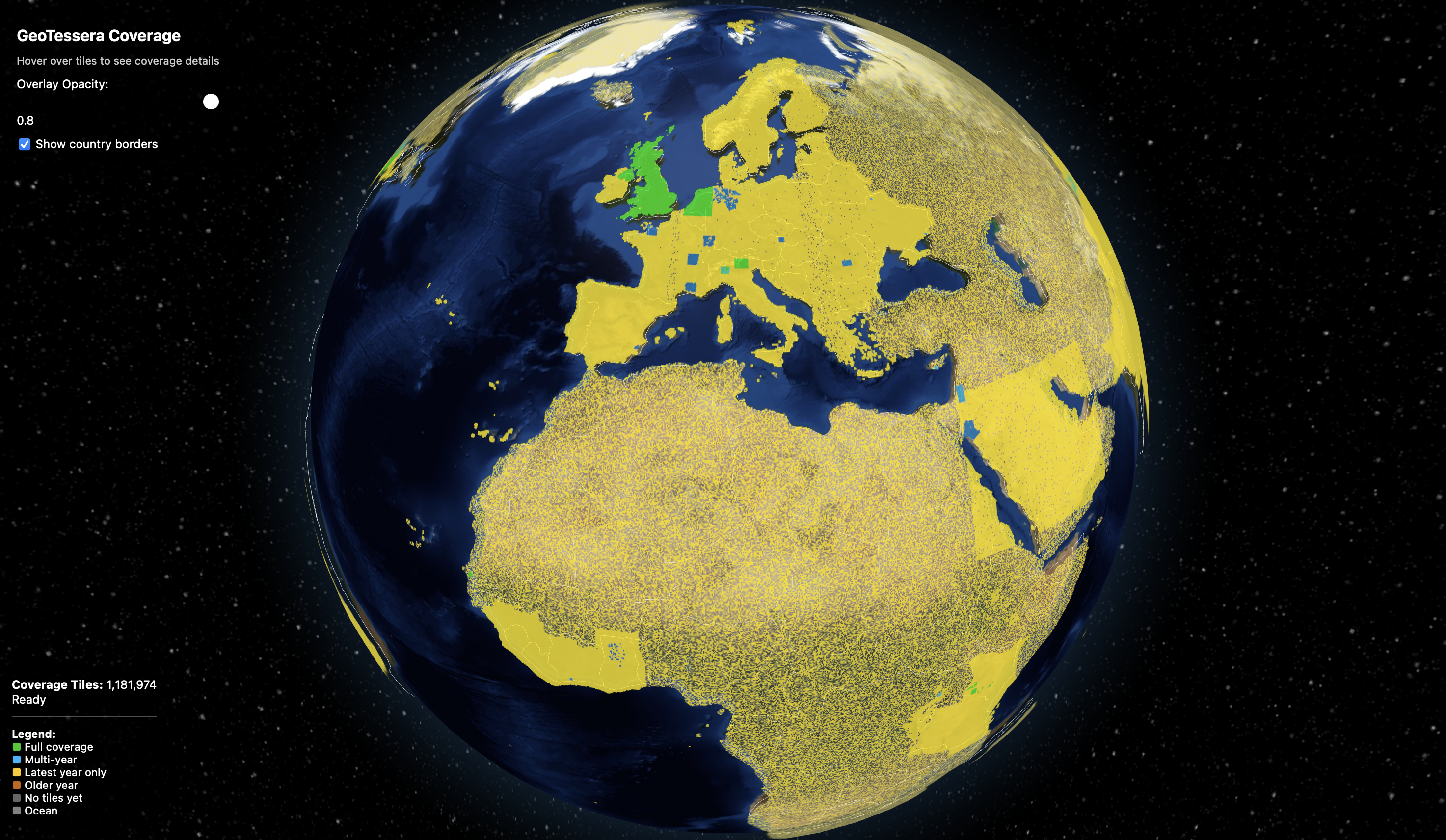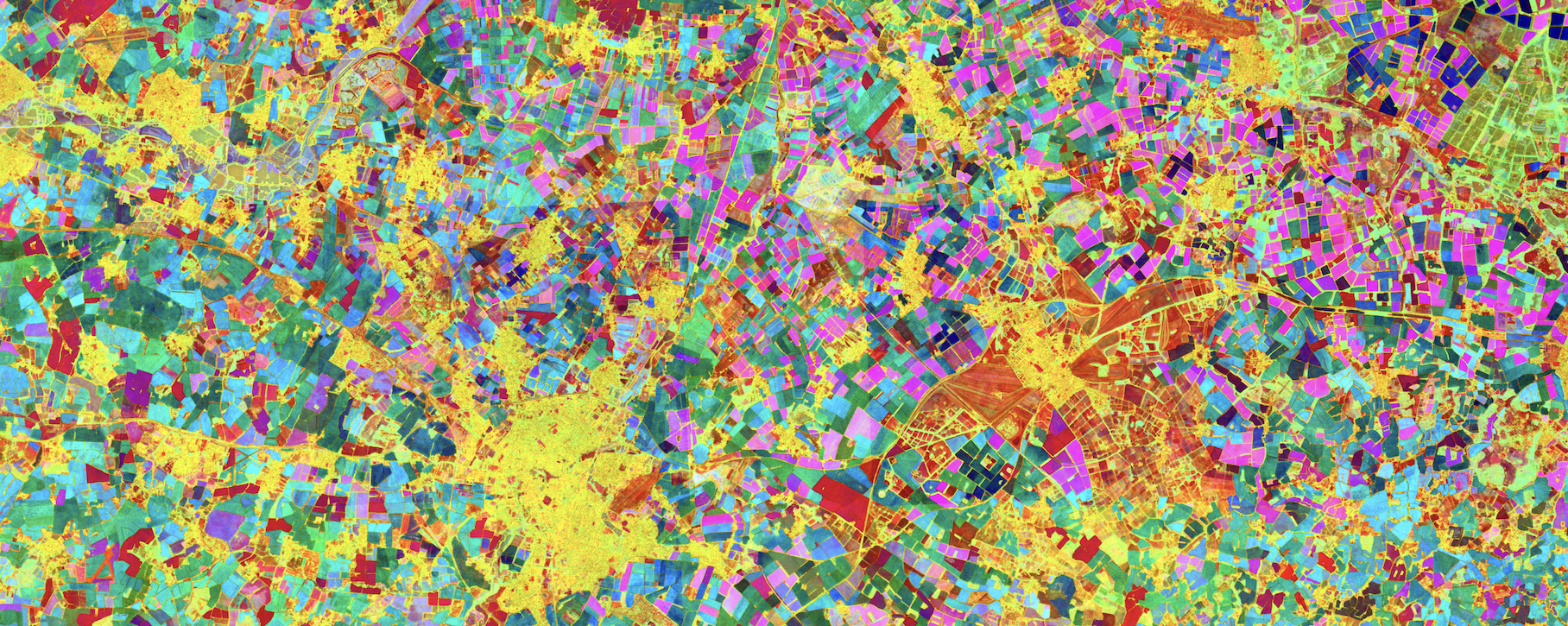GeoTessera 0.7 out with efficient sampling and Zarr support / Nov 2025 / DOI
I've just released geotessera 0.7 to pypi for our
TESSERA is a foundation model for Earth observation that processes Sentinel-1 and Sentinel-2 satellite data to generate representation (embedding) maps. It compresses a full year of Sentinel-1 and Sentinel-2 data and learns useful temporal-spectral features. -- Temporal Embeddings of Surface Spectra for Earth Representation and Analysis
With this new release, there's convenient documentation to show how you can freely access 150TB+ of CC-BY-licensed embeddings of the earth's surface. We've been getting a growing influx of requests for diverse regions of the world, and so our focus for the next few months is attaining complete coverage of our v1 model on the whole planet.
Generating and storing the world's embeddings
A new coverage map visualiser tracks our progress towards complete global embeddings;
to complete the set, we have a giant inferencing task ahead of us. AMD kindly provided us access to an MI300X cluster for us to train the TESSERA models on, and now we are using our in-house There are two numpy files in there because we store the quantized embeddings to save space. To dequantize them, the scales are multiplied to each of the bands in the main file. Geotessera takes care of this for you.

All pretty simple stuff -- it's just some floating point numbers! -- except for the sheer number of them. Each tile of vectors is around 160MB in size, and so we need around 250TB of storage per year, and we want them from 2017 through to 2024. And by the time we're done inferring all these, 2026 will be upon us and we'll need to generate another 250TBs in short order for the 2025 seasons. Ultimately, to keep up with this we need to build a scalable, open and
Earlier releases of geotessera used the Pooch library as a registry for all the embeddings. Pooch is a very convenient Python library that handles the details of fetching, checksumming and caching, but is really designed for grabbing a few large datasets, for example from Zenodo. The Tessera manifests repository for Pooch now has over a million files and takes minutes to initialise the data structures, which in turn makes using GeoTessera interactively slow.
One lesson
Now when you initialise GeoTessera 0.7+, it will download the two parquet files instead of using the old git registry. The landmasks parquet rarely changes (it just provides the mapping between ocean/land tiles and the relevant UTM projection). The registry contains the tiles for all years, and weighs in around 100MB so far compressed. In future releases, I'll probably split out them out to be per-year, which will make them smaller again, but they're all in one place for convenience right now as the size of the registry download is about the same as a single embedding tile, so it's not hugely significant to optimise at this stage.
Towards Zarr format instead of Numpy?
Hot on the heels of the 0.7.0 release,
Zarr is a community project to develop specifications and software for storage of large N-dimensional typed arrays, also commonly known as tensors. A particular focus of Zarr is to provide support for storage using distributed systems like cloud object stores, and to enable efficient I/O for parallel computing applications.
Zarr is motivated by the need for a simple, transparent, open, and community-driven format that supports high-throughput distributed I/O on different storage systems. Zarr data can be stored in any storage system that can be represented as a key-value store, including most commonly POSIX file systems and cloud object storage but also zip files as well as relational and document databases.
-- Zarr Homepage, 2025
This is exactly what we need given the giant storage requirements above, so
I've fixed up and merged this feature and included it into a 0.7.1 point
release. I've not had much chance to actually play with the format yet, but
getting it into a release is the best place to start. I got one positive
message from
More convenient APIs for sampling
The other feature that's gone into the new library are higher level APIs to use the embeddings. A very common usecase when building downstream tasks is to have to sample embeddings for a set of labels, which are then used to train classifiers. It's quite cumbersome to select these out by hand, particularly with larger regions of interest.
There is now a new sample_embeddings_at_points library call
that extracts embedding values at arbitrary lon/lat coordinates and
groups points by tile for efficient batch processing. You can see this in action
in the new geotessera-examples
repository where we're starting to put sample code for downstream tasks that
use geotessera.
The first one here is the code to detect solar panels worldwide, as demoed by

The second one is the parametric UMAP script to do false colour visualizations of any ROI. You can see a high-res "arty version" that has been contour traced using a pomap algorithm which renders as a high-res SVG as well.
Keep the embeddings requests coming!
That's it for now with GeoTessera updates. Enjoy the new releases, and if you have any requests for embeddings please get them in our queue.
References
- Feng et al (2025). TESSERA: Temporal Embeddings of Surface Spectra for Earth Representation and Analysis. arXiv. 10.48550/arXiv.2506.20380
- Jaffer et al (2025). AI-assisted Living Evidence Databases for Conservation Science. Cambridge Open Engage. 10.33774/coe-2025-rmsqf
- Madhavapeddy (2025). Programming for the Planet at ICFP/SPLASH 2025. 10.59350/hasmq-vj807
- Omar et al (2025). A FAIR Case for a Live Computational Commons. Association for Computing Machinery. 10.1145/3759536.3763802
- Madhavapeddy (2025). GeoTessera Python library released for geospatial embeddings. 10.59350/7hy6m-1rq76
- Harris et al (2020). Array programming with NumPy. Nature. 10.1038/s41586-020-2649-2